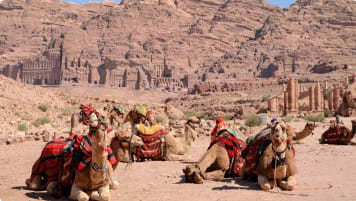Jordan: A Definitive Guide
A small group tour of Jordan for senior and mature travellers explores this ancient civilisation with visits to Petra, Wadi Rum, Madaba and other places on this tour which is often paired with Odyssey's Egypt tour.
2 Apr 20 · 7 mins read

Jordan: A Definitive Guide
The modern-day Kingdom of Jordan, a relatively young nation that emerged only in the late 19th century, occupies an ancient land. It lies in the Fertile Crescent—a region in the Middle East including modern-day Iraq, Jordan, Syria, Israel, Palestine, southeastern Turkey and western Iran—that was the birthplace of many of the world’s first civilisations. For several millennia, the territories around the Jordan River have formed part of the great trade crossroads of antiquity, leaving Jordan with a rich and complex history. The region’s strategic significance, together with its relative remoteness, marked the lands around the Jordan River as the final prize of marauding armies, and the first loss of fading empires.
In this article, we will look at the history of Jordan, and the historical sites that are now Jordan’s most popular tourist destinations, attracting curious travellers from all over the globe. We will also include a practical guide for those planning a trip to Jordan.
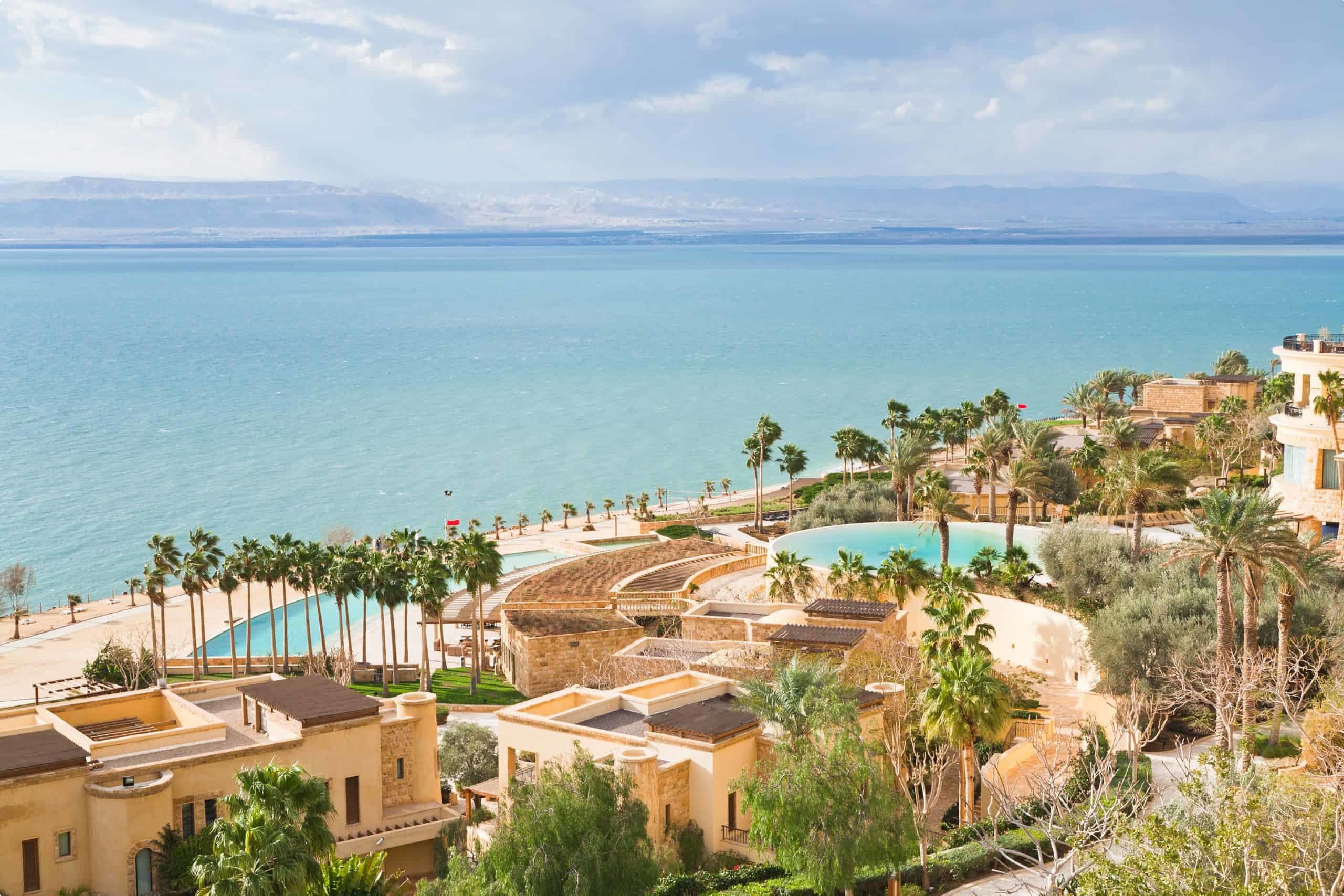
History of Jordan
Based on archaeological remains, we know that nomadic hunter-gatherers have roamed the Jordanian desert since the Early Paleolithic Period (circa 2.6 million years ago to 250,000 years ago).
Rise of Kingdoms: Ammon, Edom, Moab
Agriculture first emerged in the Fertile Crescent, and the nomads of the region began to settle into stable communities that grew into large urban centres. Jericho, located in the West Bank, is one of the earliest continuous settlements in the world, dating from about 9000 BC. Ayn Ghazal, an archaeological site in modern-day Amman, Jordan’s capital, is one of the largest known prehistoric settlements in the Near East.
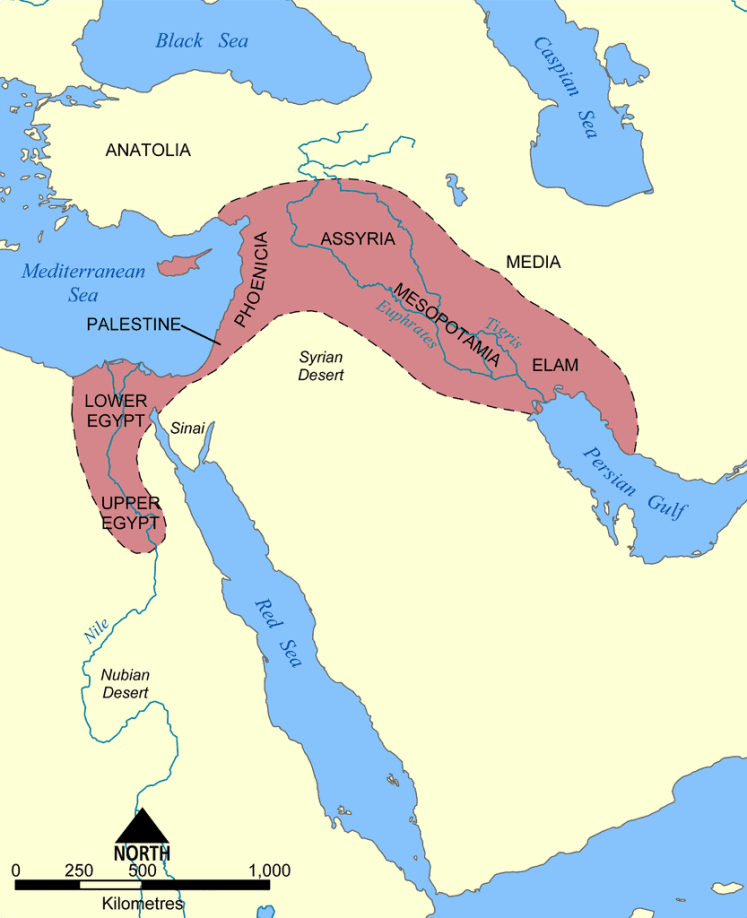
Egyptians arrived around 1580 BC and controlled both banks of the Jordan River. After the Egyptians’ withdrawal, the region became home to three ancient Semitic-speaking tribal kingdoms during the Iron Age (circa 1200 BC): Ammon, Edom, and Moab. These three kingdoms were in continuous conflict with the neighbouring Hebrew kingdoms of Israel and Judah, located west of the river.
Ammon, Edom, and Moab were mentioned in the Hebrew Bible; for example, during the time of the Exodus, Moses and the Israelites tried to pass through Edom but were refused passage. Beyond biblical accounts, we also have an archaeological artefact in the form of the Mesha Stele (or Moabite Stone), found in 1868 and now kept in the Louvre. The account inscribed on the stele commemorates Moabite victory, led by their king, Mesha, against the kings of Israel.
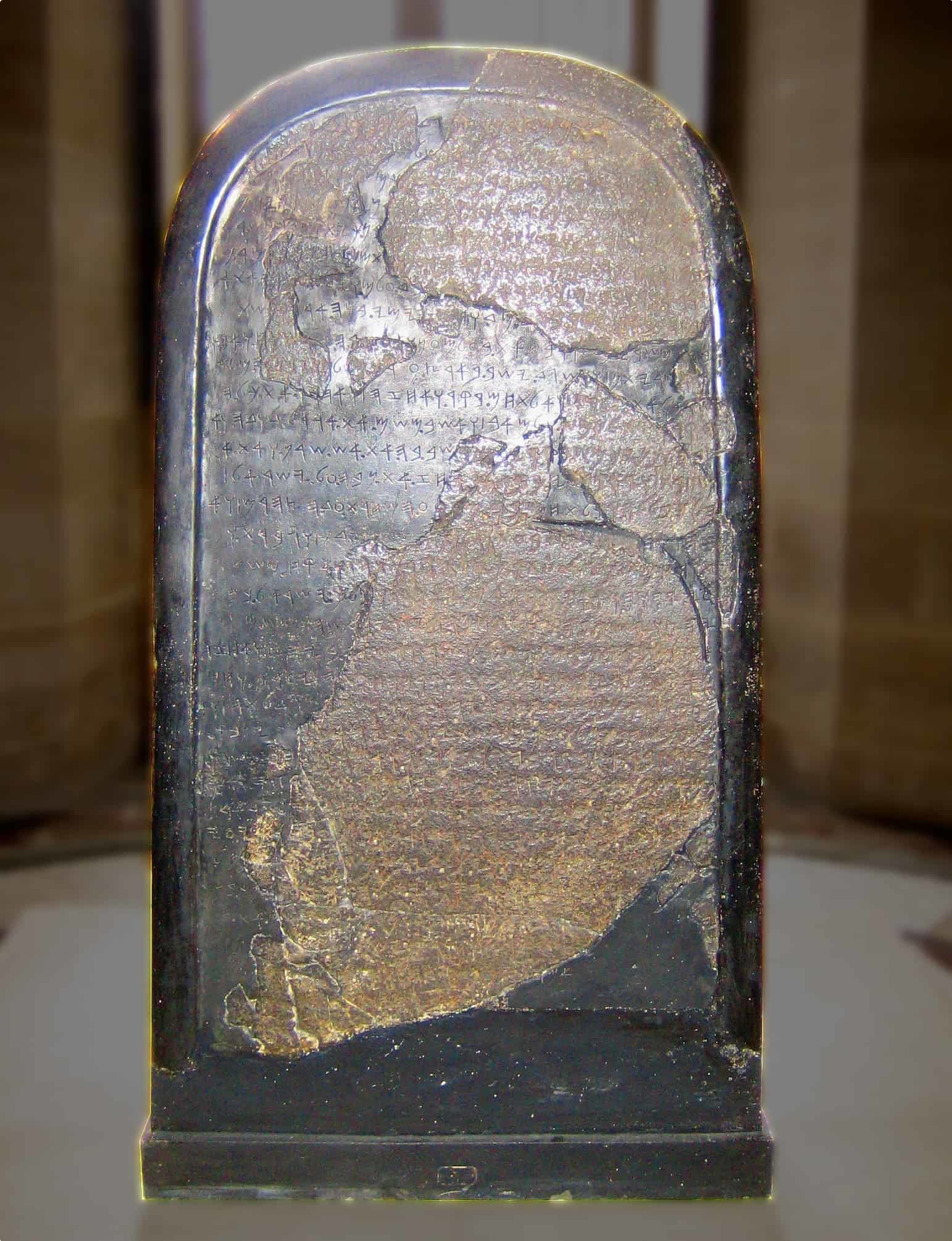
Travelling on the King’s Highway (now Highway 35 and 15 in modern-day Jordan) connecting Africa to Mesopotamia, the kingdoms traded with the Assyrian Empire, and later with the Babylonians after they seized Assyrian territory. The Babylonians were later defeated by the Persian Achaemenid Empire. From a trading partner, the kingdoms were reduced to vassals, and eventually lost their distinct cultures when Alexander the Great conquered the Persian Empire and introduced Hellinistic culture to the Middle East.
But even after Alexander the Great charged through the Levant, there was a people who flourished with their unique culture–the Nabateans in their beautiful pink-hued city, Petra.
The Nabateans
The Nabateans were Arabian nomads from the Negev Desert (in what is now southern Israel) who amassed wealth from the incense trade, and built a kingdom that wielded political power from 168 BC until its annexation by the Roman Empire in 106 AD. They half-carved, half-built their capital city of Petra in a location that was not easily accessible and with no natural source of water, but served as an excellent position for the Nabatean Kingdom to monitor the Incense Routes and to be protected by the harsh desert. The Incense Route was a network of trade routes across the Negev Desert that conveyed merchants trading frankincense and myrrh from south Arabia to the port of Gaza in the Mediterranean from the 3rd century BC until the 2nd century AD. Several Nabatean towns–Haluza, Mamshit, Avdat, and Shivta–dotted the desert along this route, serving as rest stops and trading hubs for merchants.

“Petra” means “rock” in Greek, but was originally called Raqmu, perhaps after a Nabatean ruler. In the Hebrew Bible, it is referred to by its Hebrew name, Sela, which means “rock” as well.
The Nabateans’ success on the trade routes was rooted in their ingenuity in relation to water. They dug cisterns which filled with rainwater and sustained them on the trade routes, and in Petra they built a sophisticated system of water transportation and conservation, taking advantage of the flash floods that occur in the area. To this day, the Bedu or Bedouin tribes, the settled and nomadic communities living near Petra and Wadi Rum, continue to use these Nabatean water-collecting cisterns.
Alexander the Great’s death in 323 BC split his empire among his generals. Jordan and the surrounding regions were disputed between the Ptolemies of Egypt and the Seleucids of Syria. The Nabateans remained independent as the two Greek factions fought each other but eventually fell, as did much of the Levant, to Roman rule.
Roman and Byzantine Rule
Roman rule would last four centuries. Emperor Trajan rebuilt the King’s Highway and renamed it Via Traiana Nova (Trajan’s New Road). Jerash in northern Jordan now houses the largest well-preserved Roman ruins in the world. Its ancient name was Gerasa; it is believed that the name came from gerasmenos, Greek for “elderly people”, as veteran soldiers of Alexander the Great’s campaigns in the 4th century BC were said to have been rewarded with a parcel of land in the area.
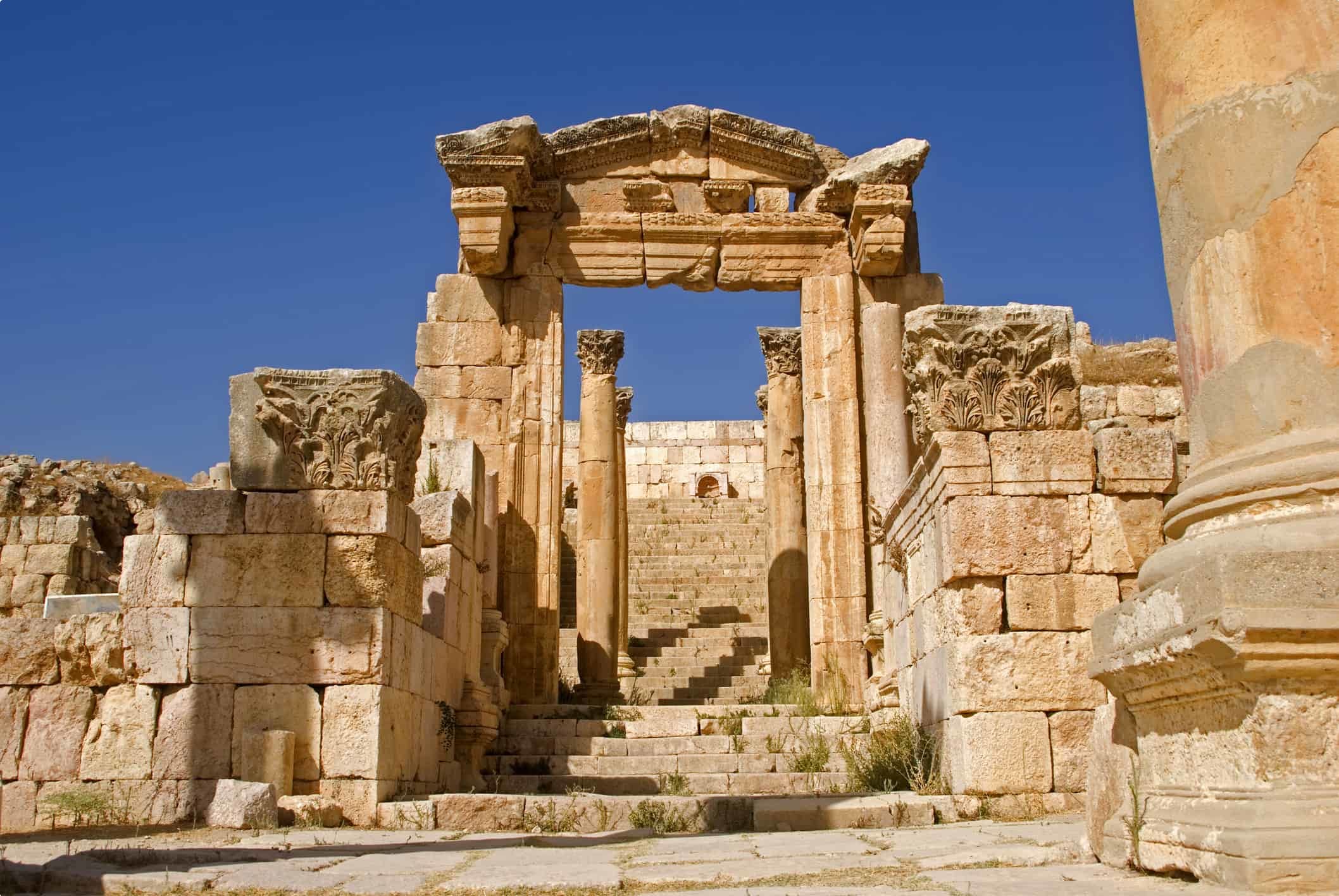
After the fall of the western half of the Roman Empire in the 4th century, the Byzantines continued to influence the region until the 7th century. Christianity became the official state religion in 380 AD, and Christian churches began to appear in the Jordanian landscape.
In 636, Syria and Palestine fell under Muslim control after the Umayyad dynasty hit the Byzantines. The Umayyad capital was established at Damascus, Syria. Jordan, far from the centre, slowly returned to a nomadic way of life. When European Christians took back control in Palestine from the Muslims in 1099 in the First Crusade, they established the Kingdom of Jerusalem, which eventually covered Jordan and nearby areas (Oultrejordain), with its capital in Karak (also spelled Kerak or Al-Karak).
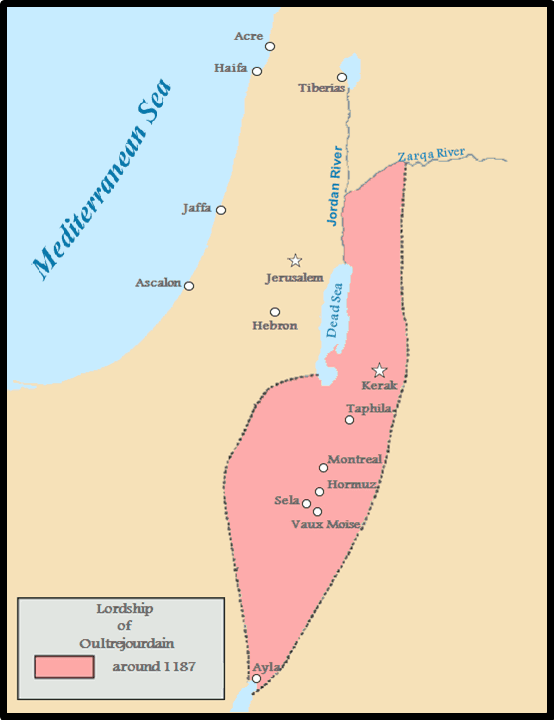
Modern Era
Jordan then fell under the Fatimid Caliphate and the Ottoman Empire, which ended Byzantine and Christian control in the region, capturing Constantinople and renaming it Istanbul.
When World War I broke out, the Ottoman Empire sided with Germany and the Central Powers. In 1916, the Arab Revolt against Ottoman rule exploded in the Middle East, further weakening an empire that was starting to buckle under Allied attack.
The Ottoman Empire was dissolved in 1923, and following British control, Jordan finally became independent in 1946.

Travel to Jordan
The desert kingdom of Jordan is a place of wonder and majesty. With a history stretching back thousands of years, past civilisations and peoples have left Jordan with an incredible cultural heritage. Jordan’s natural wonders even rival its man-made monuments.
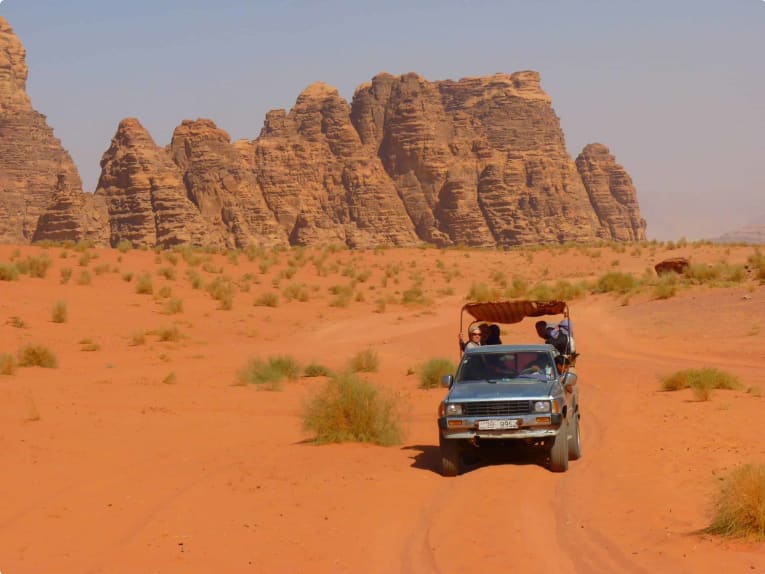
But before we look at Jordan’s highlights, here is a brief overview of what to expect:
Weather
Jordan has hot and dry summers with cool evenings. The Jordan Valley below sea level is warm during winter and extremely hot in summer. Rain falls between November and March, while colder weather conditions occur in December/January.
Most travellers try to avoid Jordan at the peak of summer (June – August) due to stifling temperatures, with particularly extreme heat in the desert. Reflecting this, our tours typically leave in January, April and October so that you can discover Jordan in relatively pleasant temperatures.
What to Wear
While Jordan is relaxed about women’s dress compared to some of its neighbours in the Middle East, travellers should still bear in mind that Jordan is a majority Muslim country (97.2% Muslim, predominantly Sunni, 2.2% Christian) and err on the side of modest clothing. Make sure to cover your arms and legs in light long-sleeved shirts and long pants or skirts. Think about bringing a scarf in order to cover up if you visit a mosque – you can also use it to protect yourself from the desert sun.
Men, too, should dress respectfully – in particular, take into account that most local men will not be wearing shorts!
Language
The official language of Jordan is Arabic, which is spoken by the vast majority of the population. Due to the British colonial history, English is widely spoken. Don’t worry if you don’t know the language; on an Odyssey Traveller tour, you will be consistently accompanied by local guides who speak the language and will be able to help you.
Cuisine
Food in Jordan bears many influences from the cuisines of the wider Levant, as well as some influences from Turkey and the former Ottoman Empire. The national dish of Jordan is mansaf, lamb cooked with fermented dried yogurt powder and served with rice.

Mezze dishes are a mainstay of of Jordanian cuisine. A selection of small dishes often served at the beginning of multi-course meals, mezze include a variety of different dishes including fattoush (a salad of garden vegetables and pieces of pita bread), tabbouleh (a dish made of bulgur, tomatoes, parsely, mint and onions) and hummus (chickpea puree with tahini, olive oil, lemon juice and salt).
Tea and coffee are central to any social occasion in Jordan, with coffeehouses functioning as social hubs in Jordan’s towns and cities.
Although Jordan is a Muslim-majority country, alcohol is not a social taboo, with arak (an aniseed-flavoured alcoholic beverage) often served with meals. This traditional alcoholic beverage is also familiar to people living not only Jordan but also in nearby regions such as Iraq, Syria, Israel, Palestine and Lebanon.
Many different varieties of delicious fruit juices are produced and consumed throughout the year to deal with Jordan’s often scorching heat, including pomegranate juice, apricot juice, and lime-mint juice.
Now here are snapshots of Jordan’s highlights for interested travellers, with links to our own published articles diving deeper into each destination.
Highlights of Jordan
Petra
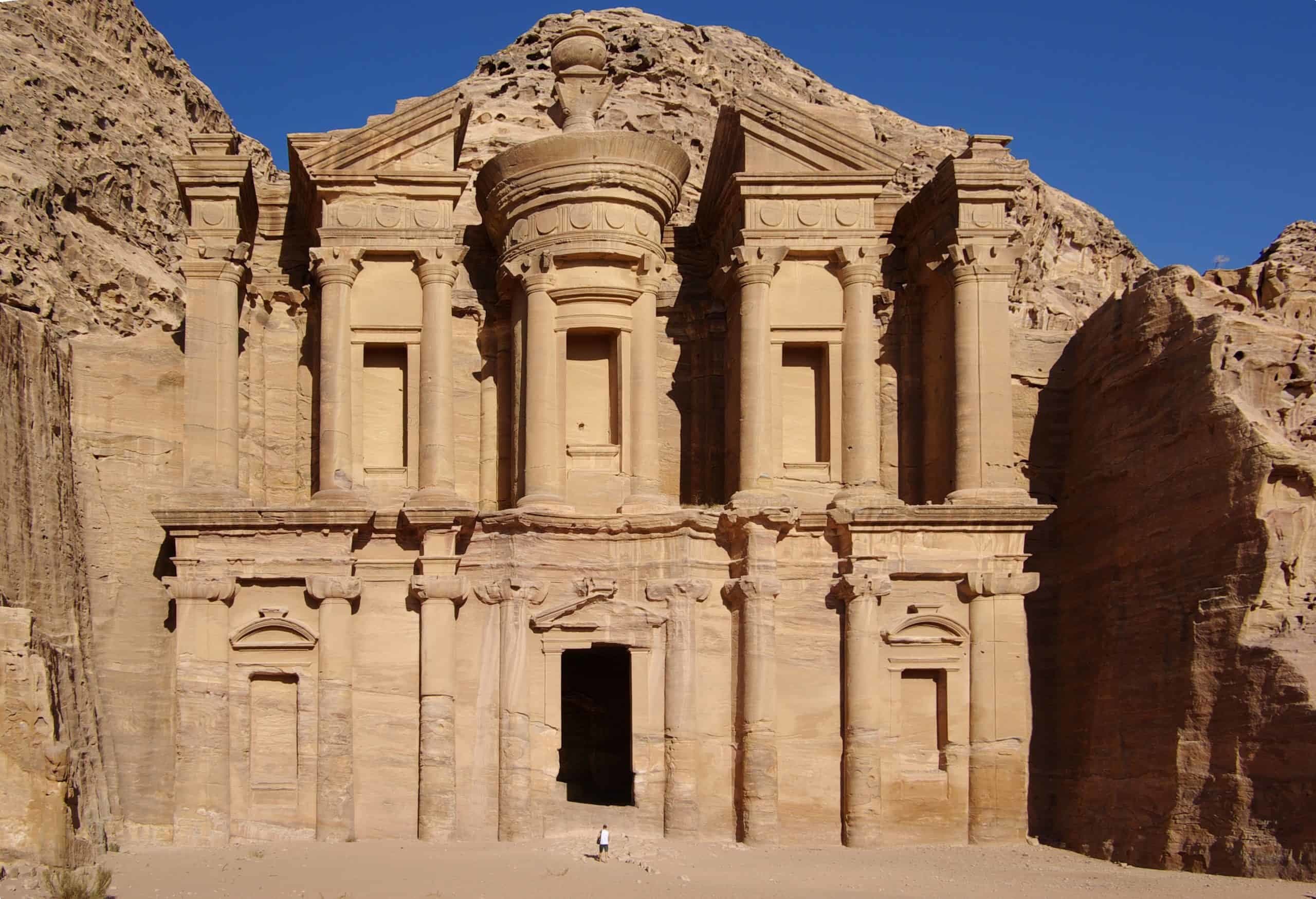
Petra (“Rock”), situated between the Red Sea and the Dead Sea, was once the capital of an ancient kingdom of the Nabateans that flourished during Greek and Roman times, its impressive ruins and archaeological wonders located in what is now southwest Jordan. In 1985, it was declared a UNESCO World Heritage Site. The biblical scholar John William Burgon described it as a “rose-red city half as old as Time” due to the pink hue of its sandstone cliffs and its historical significance. Some 2,000 years ago, the “Rose City” was carved from sandstone, at the head of which is Wadi Musa, or the Valley of Moses, which according to tradition was where Moses struck a rock with his staff and water gushed forth into the desert. Read more about Petra.
Amman

Amman is the capital and largest city of Jordan. It is the seat of government and the city where the king resides, and among the most modernised Arab cities. Built on the rolling hills of the Aljun Mountains, Amman is a relatively young city, dating to the late 19th century, though it has seen human settlement since the days of antiquity. Fortified settlements had risen on what is now Amman’s highest hill, Mount Al-Qal’ah (Jebel Al Qala’a or Qala Mountain, 850 metres above sea level), for many centuries. The earliest remains date from 4,000 BC. It later became the capital of the Ammonites, an ancient Semitic-speaking people who called their capital Rabbath Ammon, with Rabbath meaning “Capital”. This city is also mentioned in the Hebrew Bible. Located on the ancient trade route, the King’s Highway, Amman grew prosperous from providing natural resources for construction, such as sandstone and limestone.
Under the Islamic era, the city was renamed “Amman” again and was integrated into the caliphate. Following annexation by the Ottoman Empire, Amman was resettled by refugees from the Caucasus who were fleeing Russian conquest in 1878. Amman became capital of a new state carved away from western Palestine by the British in 1921, and was further developed following Jordan independence in 1946.
A must-see is the Temple of Hercules, the Citadel’s most significant Roman structure, with six columns standing 10 metres tall, and fragments of a 12-metre stone statue of Hercules. Another incredible site in the Citadel is the Umayyad palace, built during the 8th century. Read more about Amman.
Jerash
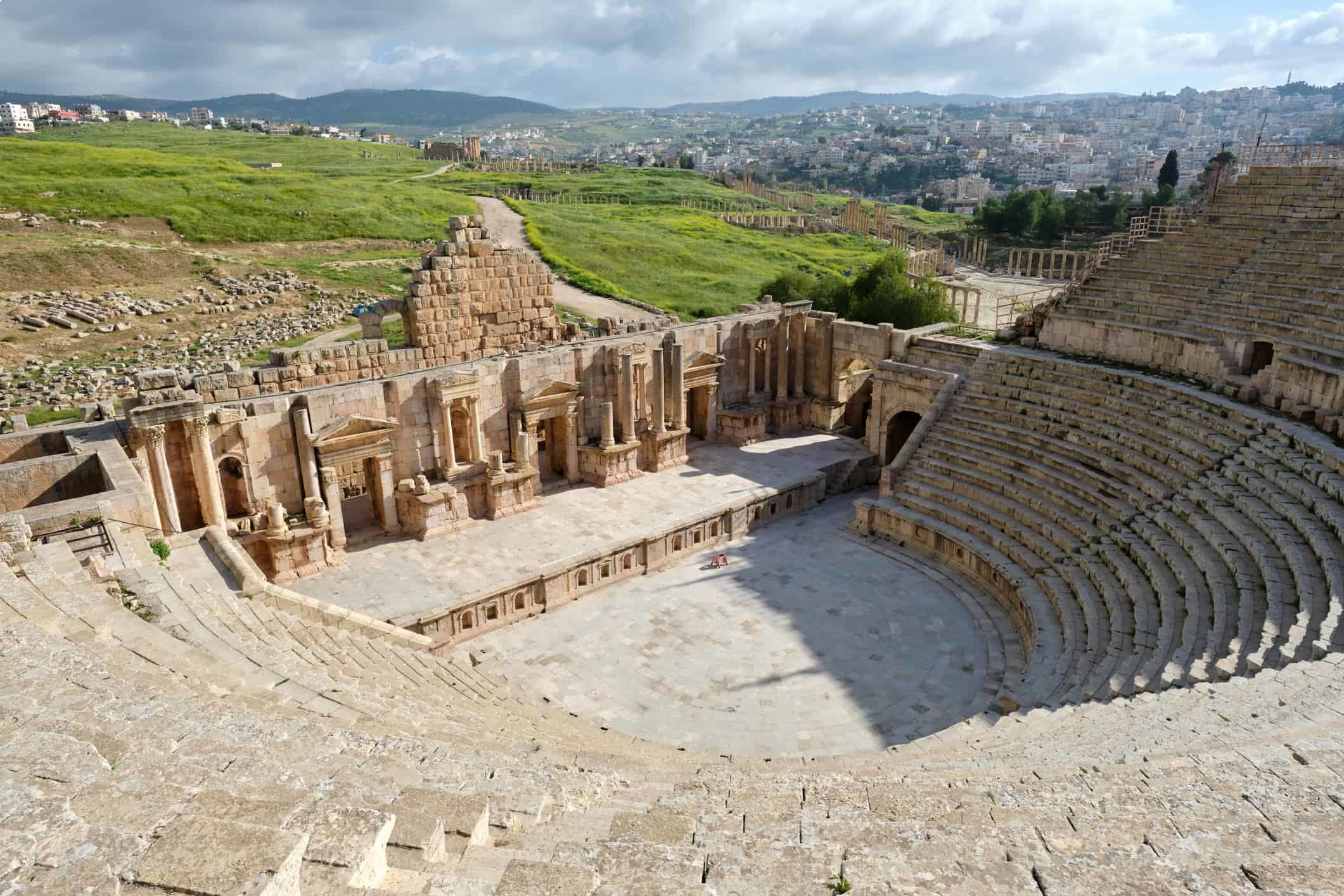
Jerash in northern Jordan is noted for its well-preserved Roman ruins, one of the largest in the world. Located 48 kilometres (30 miles) north of the capital, Amman, the Jerash ruins is one of Jordan’s most popular tourist sites, alongside the ruins of Petra. The archaeological site is a relic of Jerash’s founding during the Hellenistic period, and its golden age as a prosperous city under the Roman Empire. Currently on the tentative list of UNESCO’s World Heritage Sites, it is considered an ancient meeting place of the East and the West.
Many of the buildings and structures remaining in Jerash date from the 2nd century AD. Hadrian wintered in Jerash in 129 AD, his stay celebrated with the construction of a triumphal arch (Hadrian’s Arch). In 150 AD, the Romans began constructing a temple with Corinthian columns honouring Artemis, the goddess of the hunt and the patron goddess of Jerash. Read more about Jerash.
Madaba

Madaba is a town in west central Jordan situated on a highland plain 760 metres above sea level, 32 kilometres south of Amman. It is famous today in historical cartography for the Madaba mosaic map, a 6th-century mosaic map of Jerusalem and the Holy Land housed in a Greek Orthodox church, and for its collection of beautiful mosaics from the Byzantine era. Read more about Madaba.
Shobak Castle
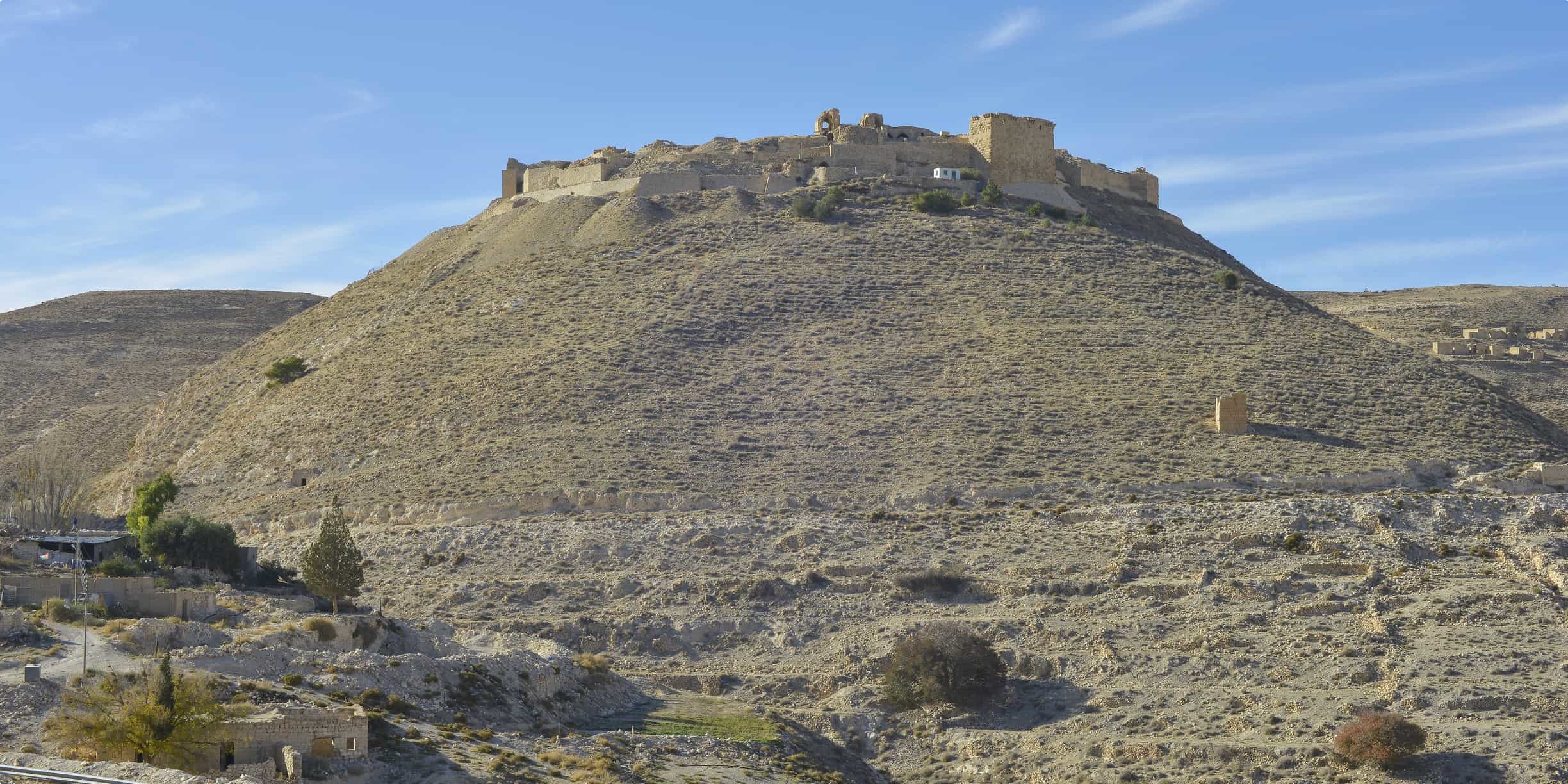
Shobak Castle is the name given to the ruins of a Crusader castle perched on a rocky hill in the modern town of Shobak (or Shoubak) in Jordan. The hill was formerly called Mons Realis, Royal Mountain, which gives the traveller an idea of the castle’s former might and majestic location. The castle was built in 1115 by Baldwin I during his expedition in the region. He was the first king of the Crusader state of Jerusalem from 1100 to 1118, and played a key role in expanding the kingdom and establishing a form of rule that would serve as a model for the Franks in Syria and Palestine for 200 years. Read more about Shobak Castle.
Wadi Rum
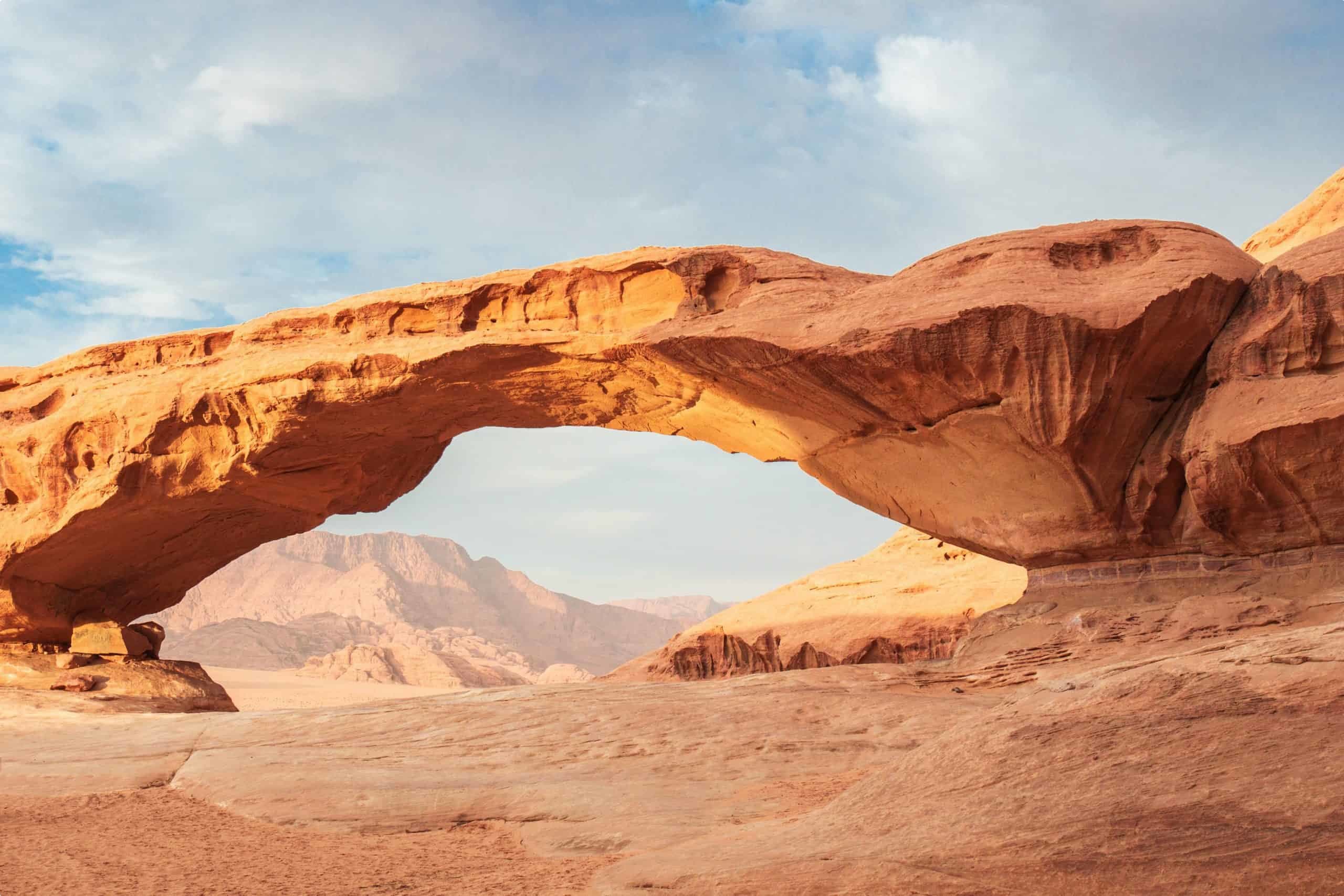
Wadi Rum in southern Jordan is the largest wadi (valley) in the country. About 60 kilometres east of Aqaba, this valley in the Jordanian desert, where famously Lawrence of Arabia was filmed and where the Bedouin tribes reside, cuts into sandstone and granite, producing a varied red desert landscape and unique scenery. A UNESCO World Heritage Site, the Wadi Rum Protected Area joins the ancient city of Petra near the Red Sea, Jerash, the Dead Sea, and Mount Nebo, as Jordan’s most visited tourist destinations. The 74,000-hectare protected desert area, relatively unspoilt and isolated, features towering cliffs and huge caverns. Well-known formations include the Jebel Rum (also spelled Jabal Rum), the Jebel Burdah rock bridge, the Khazali canyon, and the “Seven Pillars of Wisdom” rock formation, named after Lawrence’s book. Read more about Wadi Rum.
Mount Nebo
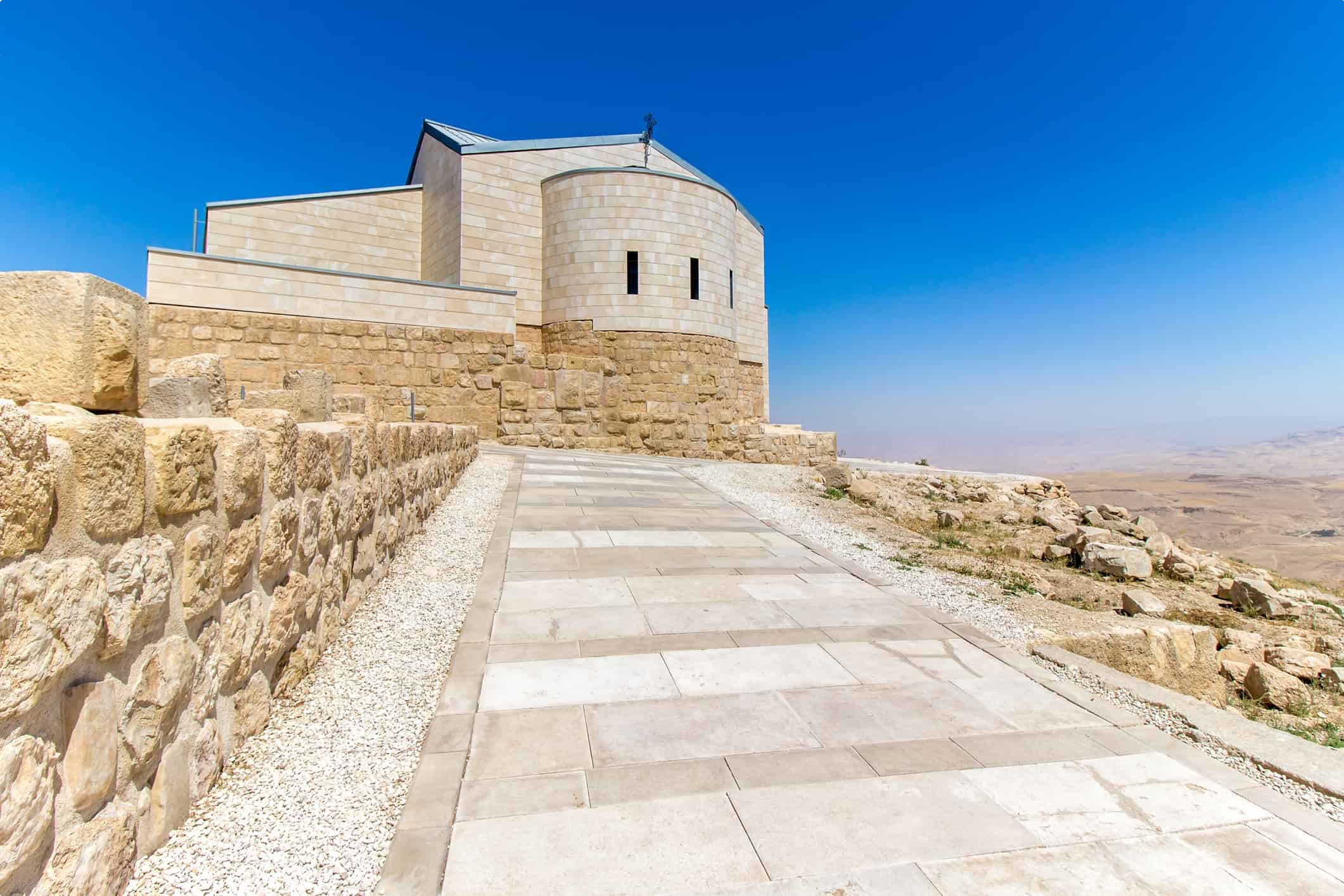
Mount Nebo is the highest point of the Abarim mountain range that cuts across Jordan and which culminates in the Arabian desert in the south. Located in the historic city of Madaba, east of the Dead Sea, Mount Nebo is a revered holy site. According to the Hebrew Scriptures, Moses, who led the Israelites in an exodus out of Egypt across the desert for 40 years, stood on the summit of Mount Nebo and was granted a view of the Promised Land. Moses’ life ended not long after, and the area was also believed to be the burial place of the prophet, though the exact location remains unknown.
Mount Nebo is a treasured part of Jordan tours. Travellers can climb to the summit of the 800-metre mountain and view an exquisite panorama of parts of the Holy Land, visible on a clear day. The mountain peak offers a view of the Dead Sea, the West Bank city of Jericho in the Jordan River valley, and the hills of Jerusalem. Read more about Mount Nebo.
The Dead Sea
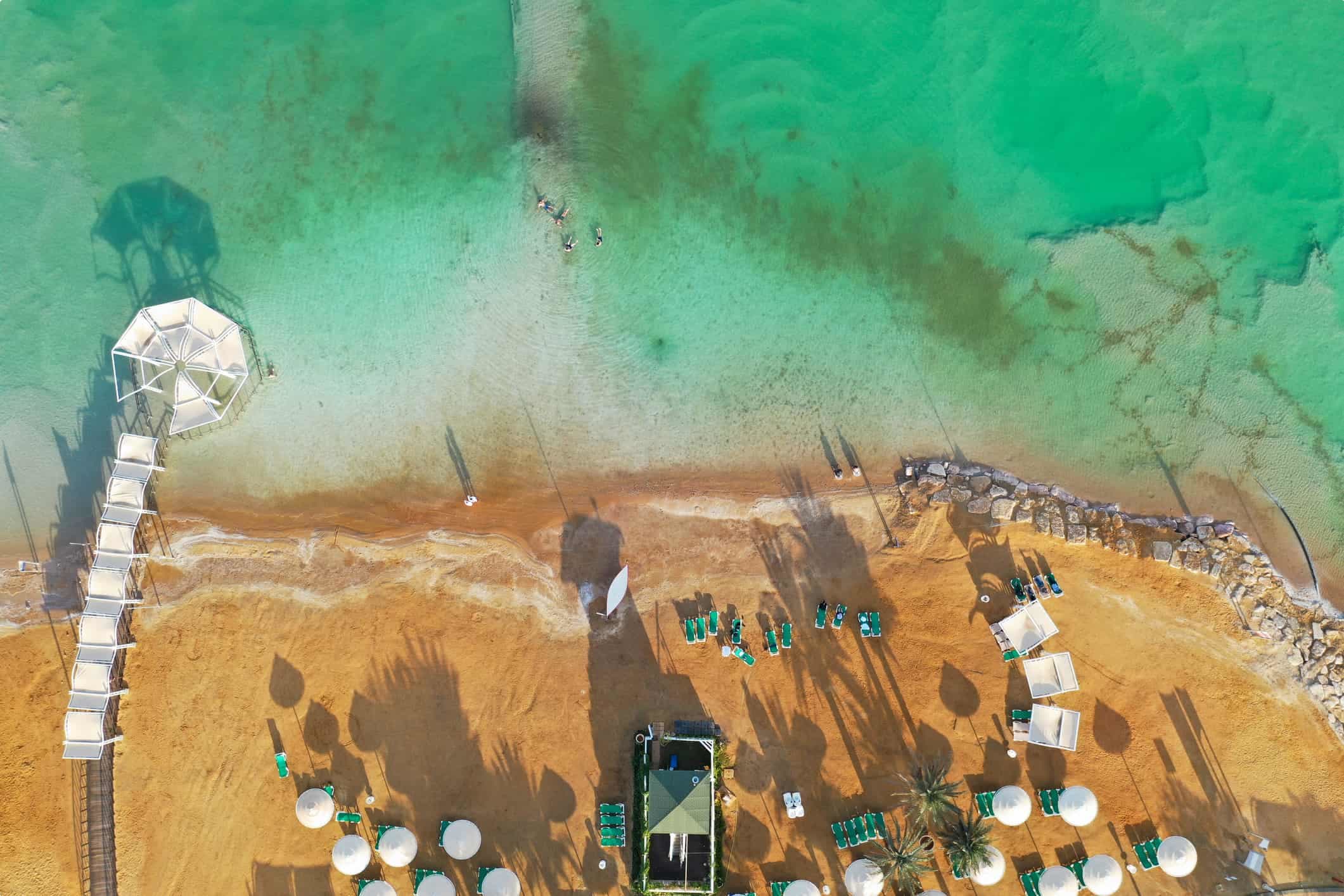
The Dead Sea is a landlocked salt lake bordered by Jordan to the east and Israel to the west. It is located 430.5 metres (1,412 feet) below sea level in the Jordan Rift Valley, the lowest point on earth, and receives nearly all its water from its main tributary, the Jordan River. The Judean desert, where jeep safari tours often explore the desert landscape, descends here. This area is a major tourist destination in Jordan and Israel, with travellers attracted by its warm, mineral-rich, salty water. This amazing lake’s salinity is unusually high at around 30-35%, compared to 3% in other bodies of saltwater. This salinity also gives it the high density that keeps bathers floating on the water.
This lake in the lowest place on Earth is called “dead” precisely because the high salt content prevents fish and aquatic plants from living in it. The fish that the Jordan river carries with it dies quickly in the Dead Sea, though microorganisms such as bacteria and algae survive. The lake also supports birds that pass through the desert during their migrations.
On a tour of the Dead Sea, you can stay in a spa hotel and enjoy bathing in the lake, followed by a therapeutic mud bath. Dead Sea water and its black mud are said to have minerals that can have positive effects on the skin and the body, a boon for sufferers of psoriasis, acne, chronic back pain, and arthritis. Read more about the Dead Sea.
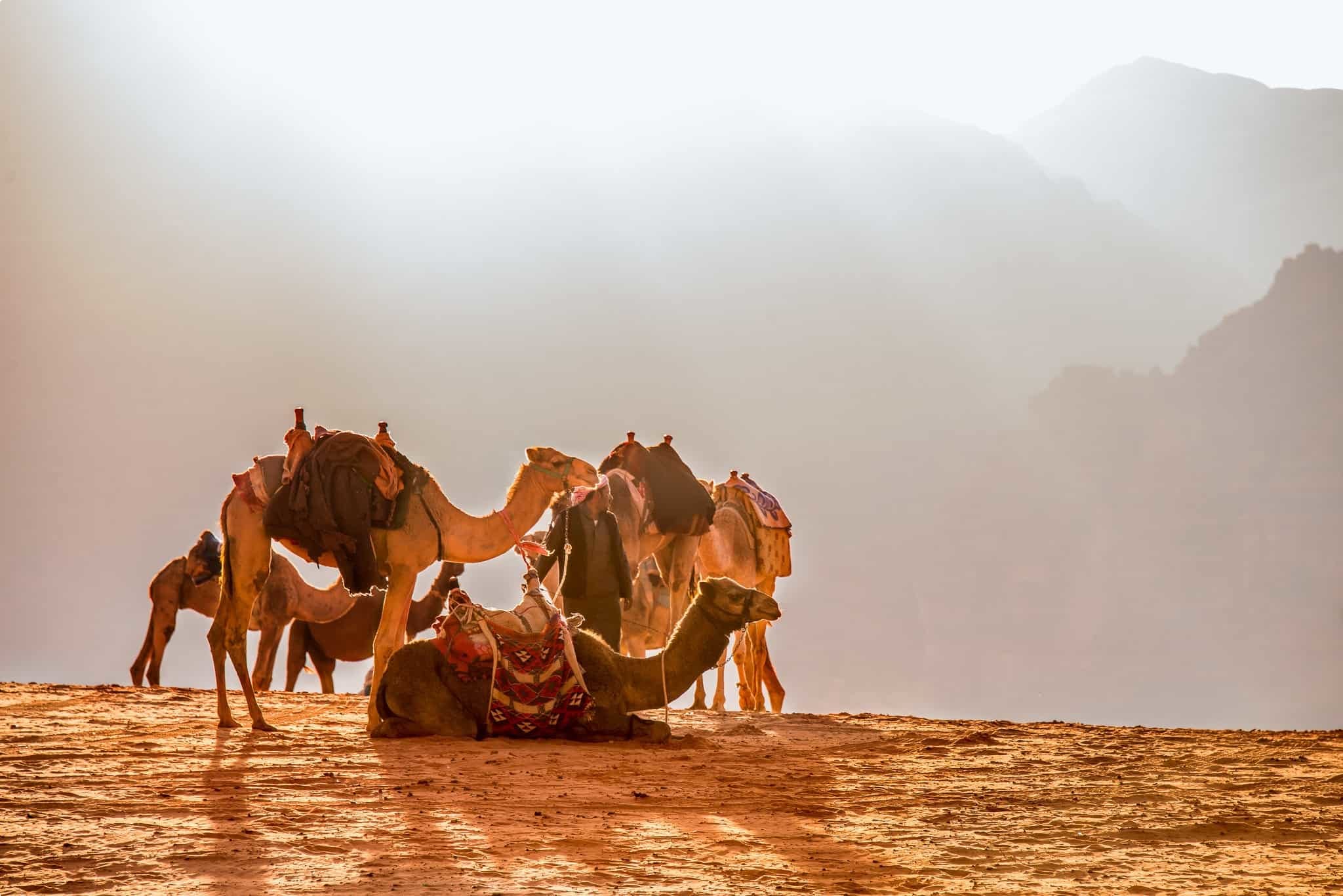
If you want to learn more, visit our Jordan country page and join our small group tour. Our tour of Jordan visits these sights and more, and is paired with Odyssey Traveller’s small group tours of Iran or Egypt.
Articles about Jordan published by Odyssey Traveller:
For all the articles Odyssey Traveller has published for mature aged and senior travellers, click through on this link.
External articles to assist you on your visit to Jordan:
Related Tours
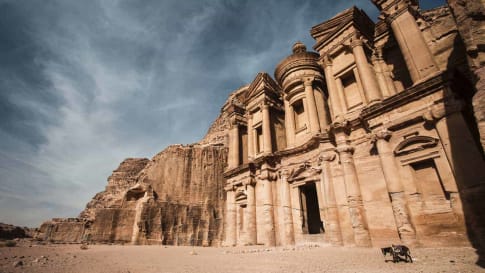
9 days
Jan, OctAncient History of Jordan | Escorted Small Group Tour
Visiting Jordan
Explore Jordan, visiting its capital city, Amman Jordan, the ancient Desert Castles, Petra and the Dead Sea on a small group package tour for mature and senior travellers travelling as a couple or Solo.
From A$6,750 AUD
View Tour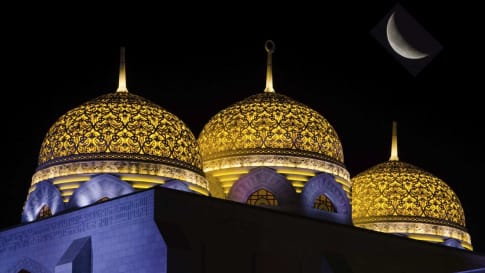
13 days
Oct, SepDiscover Oman
Visiting Oman
The Sultanate of Oman is a country of diverse natural beauties and fascinating human history. Oman boasts medieval forts and watchtowers, Bedouin villages, spectacular fjords, bustling markets, date palm plantations, and sand dunes.
From A$11,595 AUD
View Tour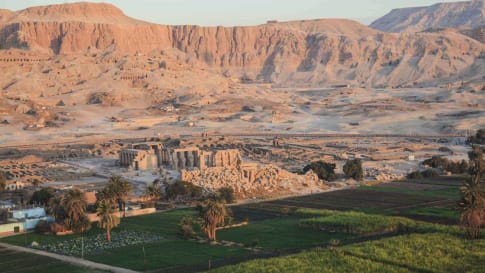
18 days
Nov, JanEgypt tour: escorted small group history & cultural tour of Egypt
Visiting Egypt
Our small group program for senior and mature couples and solo travelers takes us to contemporary feats such as the Aswan Dam and also to current crucibles of the Egyptian experience such as Tahrir Square. Proof, were it needed, that Egypt’s role as the pivot of civilisation is far from ended. There is the opportunity to visit our Morocco, Jordan or Iran tours before embarking on this tour of Egypt.
From A$12,950 AUD
View Tour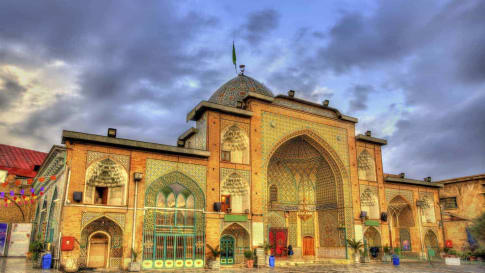
17 days
Sep, Nov, AprIran Culture and History Escorted Small Group Tour for seniors
Visiting Iran
Unlike its neighbours to the west and northwest, Iran had not adopted Christianity and it was the explosive spread of Islam and its ready adoption, without the Arabic language or customs, which helped unite the culture and greatly enrich Persian heritage. This small group tour program includes the great cities of Iran, historic sites, mosques, gardens, bazaars and teahouses for couples and solo travellers.
From A$11,825 AUD
View Tour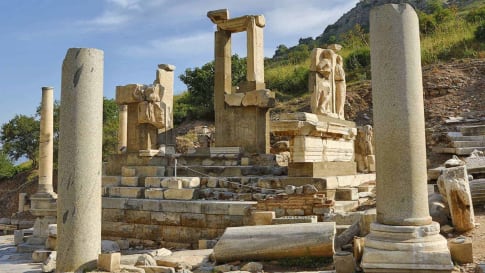
21 days
Apr, AugSmall group tour of Ancient Turkey
Visiting Turkey
As a travel company we seek to keep guests off the beaten path. Trips that are remembered for authentic experiences. Our small group journeys in Turkey are fully escorted by an experienced local guide and an Odyssey guide to give this type of experience whether at one of the many UNESCO World heritage sites explored or local bazaars. It is always about the adventure and memories that we will create.
From A$17,295 AUD
View Tour
